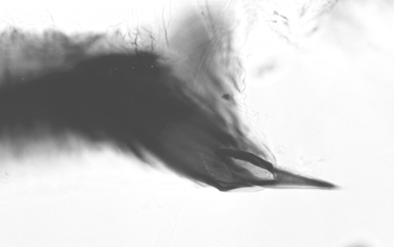C. 'queenslandicus' immaturesLarva: Medium size melanotus-type larva, length about 10.7 (9.7-11.3) mm in females; 10.8 (10.2 & 11.3) mm in males. Posterolateral tubules about 300 - 400 micron. Length of ventral tubules about 1.45-1.9 mm (anterior) and 1.9-2.5 mm (posterior). Anal tubules about 400-560 micron in length, about 3 times longer than wide and tending to be constricted near the middle.
Head capsule with posterior third of gula very slightly to slightly darkened, as is frontoclypeus.
Mentum (Fig. c) with 4th lateral slightly reduced, almost to the level of the 5th lateral (type I or II), c2 teeth hardly separated from c1 (type IB).
Ventromentum (Fig. d) with about 37-47 striae which reach at least two thirds to the smooth anterior margin; with some obvious lumps at the lateral ends; distance between inner margins about 0.17-0.28 of mentum width.
Pecten epipharyngis (Fig. a) with about 13-19 somewhat irregular teeth, often with one or more small teeth.
Premandible with teeth about equal in length, inner tooth about 1.8-2.3 times wider than outer tooth.
Basal segment of antenna (Fig. b) about 3.3 to 4.4 times longer than wide, Ring organ generally between a third and a half way up from base of segment, which does not have an extended foot; AR about 1.53 (1.4-1.64); A2/A1 about 0.33 (0.28-0.35); A4/A3 about 1.48 (1.1-1.73) antennal segment proportions (micron) 106 : 35 : 11 : 16 : 7.
Mandible (Fig. e) with third inner tooth darkened and separated (type III), about 20 (19-23) grooves on outer surface near base; about 12 (10-14) bristles in Pecten mandibularis. Cytology: 4 polytene chromosomes with the thummi arm combination AB, CD, EF, G (Only other known species possibly of this cytocomplex in Australia is C. javanus).
Arm G with a subterminal nucleolus and a BR near the middle of the arm. No nucleoli in the long chromosomes.
No polymorphism in the known specimens.
qldA1:
qldB1: Large puff (groups 7) about one third from distal end, with dark bands (group 8) proximal to it.
qldC1: Distinctive band groups 3-4 about one third from distal end.
qldD1: 1a - 7, 14 - 19f, 8 - 13, 19g - 23 (preliminary by Kiknadze)
qldE1: 1 - 3c, 6g - 10b, 3de, 6f - 3f, 10c - 13 (preliminary by Kiknadze)
qldF1: 1 - 10, 17 - 11, 18 - 23 (preliminary by Kiknadze)
qldG1: subterminal nucleolus and probably three BRs evenly spread through rest of arm. Pupa: A typical Chironomus pupa. Exuvia relatively pale, brownish; various characters as in Table below.
Respiratory base essentially kidney shaped, about 129-153 µm long and about 2.5 times longer than wide. Hook row of segment II occupying about 2/3 of width of segment. Slender L seta on anterior margin of conjunctives III/IV and IV/V, that of IV/V generally longer (abt 115 cf. abt 90 µm).
Pedes spurii of segment II very obvious, barely visible on segment II, pedes spurii A of segment IV well developed, length about 190 µm, but just a patch of spines on segment V. | | | Females (2) | | Males (4) | | | Mean | Range | Mean | Range | | Length (mm) | 7.36 | 7.07 - 7.64 | 6.97 | 6.67 - 7.32 | | Inner margin wing case (mm) | 1.47 | 1.45 - 1.48 | 1.36 | 1.27 - 1.49 | | Cephalic tubercles (µm) | 61 | 51 - 72 | 71 | 64 - 82 | | Cephalic bristles (µm) | 46 | 43 - 49 | 38 | 37 - 38 | | HR | 2.40 | 2.21 - 2.48 | 2.27 | 2.11 - 2.48 | | Len. PSA of abd seg IV (µm) | 150 | 150 | 168 | 105 - 195 | | Hooks on abd. segment II | 69 | 64 - 74 | 72 | 64 - 82 | | Swim fin taeniae (one side) | 78 | 78 - 79 | 62 | 47 - 72 |

Caudolateral spur of segment VIII (above) generally with only 1 spine, but sometimes with 2.
Shagreen pattern slightly stronger in female than male, particularly in segment VI, where that of male is barely visible. There is strong shagreen on midline of segment II, spreading laterally to segment IV, then reducing again in segment V, and small area of very fine spines in VI.
Taeniae of swim fin mostly in a single row, but becoming a double row at posterior end.Larva very similar to that of C. sp. (bathophilus type) but differing in the presence of lateral tubules and a slightly higher AR. See also C. 'queenslandicus' adult | C. sp. (bathophilus-type) larva.[ Return to Index | Go to References ] |
